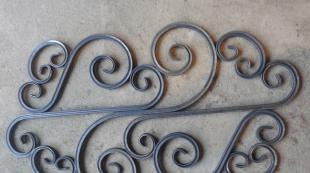Ways to clean sewer pipes at home. How to clean the sewer using different methods Methods for cleaning sewer pipes
Partial or complete clogging of sewer pipes can happen in every home. Usually this happens suddenly, being a complete surprise for the owners of an apartment or house. However, this phenomenon may be preceded by some signs. For example, a decrease in the speed of draining water, the appearance of an unpleasant odor from the pipes. In order not to call plumbers every time, each person must imagine how to clean sewer pipes at home if they are clogged. Moreover, there are always available cleaning products or items at hand.
Determining the blockage that has arisen is easy. Water stops going down the drain, or goes too slowly. If the drain grate of the plumbing fixture is not clogged with anything, then there is a blockage.
Drain pipes are often clogged with food debris, objects, hair, threads that accidentally fall into the drain. Also, a large object, such as a rag or sponge, can get into the pipe, around which a cork of small particles will gradually grow.
Another reason for the formation of blockages is the gradual decrease in the cross section of drain pipes. On the walls of drain pipes, usually cast iron, a layer of fat is gradually deposited, which leads to a decrease in the drain rate, up to its termination. Plastic pipes are much less likely to suffer from such deposits. In any case, you need to know how to clean the sewer at home. There are several ways to deal with such a nuisance. You can use any of them, whichever is more to your liking and capabilities.
Determining the location of the blockage
Before you clean your clogged sewer pipes with your own hands, you need to determine the location of the blockage. This will make it easier to eliminate it. Blockages often form at the bends of drain pipes. In particular, in the siphon itself, at the outlet of the kitchen or bathroom siphon. These are places in the areas between the plumbing fixtures and the drain riser. Sometimes internal risers are also clogged, although much less often. If the common riser of an apartment building is clogged, then you can’t do it on your own and by methods.
You can identify the approximate location of the blockage yourself. To do this, you need to check how the drain from different points works. Suppose, in the kitchen and in the toilet, the water drains normally, but it does not leave the bath. Therefore, the cause must be sought in the area between the bathroom and the riser. If the water does not leave different devices, then the reason is a common riser.
Pipe cleaning methods
Consider how to clean the sewer pipes in a house or apartment. It is recommended that you first check the siphons under the sink or bathtub. To do this, they have to be carefully disassembled, and then rinsed with water. In most cases, blockages are located precisely on the bends of the siphons. If the siphon is clean and the water still does not come off, you should use one of the methods listed in this article.
thermal method
Pour 1-2 liters of boiling water into the drain hole. It is able to dissolve fatty deposits, as a result of which the drain passage will be released. This method cannot be applied if there is water in the sink or other plumbing fixture.
mechanical way
For cleaning, you can use the following tools:

Tip: For a plastic pipeline, a metal cable must be used with caution, as it can, due to its rigidity, damage the pipe walls.
Chemical method
Consider how to clean the pipes with one of the chemicals. There are special liquids and powders on sale, with which you can dissolve fat deposits inside the drain. These are Mole, Flup, Mister Muscle, MELLERUD, Tiret Turbo, Sanfor. The liquid is immediately ready for use. It is poured into the drain hole of the plumbing fixture, and then left for a while. The powder must be poured into the drain, and then pour the specified amount of water. After maintaining the specified time, the drain system is washed with water.
All chemicals are divided into 2 groups:
- Acid. They perfectly dissolve hair and cope with soapy plaque. Such preparations are more suitable for bathrooms;
- alkaline. Their purpose is to dissolve fats that accumulate on the inner pipe walls. Such tools have proven themselves better in the kitchen.
Important: The simultaneous use of alkali-based products and acid preparations is prohibited.
Household solvents
How to clear a blockage in sewer pipes if there are no purchased chemicals available? You can use all known folk remedies:
1. Baking soda. It can be used in several ways:
- Half a pack of soda should be poured into the drain, and then pour the same amount of vinegar into it. Such a mixture effectively dissolves any fatty deposits on the walls of the pipes. It is recommended to close the drain with a stopper. After application, you need to wait about 2 hours without opening the drain. After a time when the reaction stops, the drain must be washed with running water;
- Soda is poured into the drain hole, after which boiling water is poured there. The reaction of soda to boiling water is gas formation with the release of carbon dioxide. This helps keep the pipes clean.
2. Salt mixed with baking soda. Ingredients in equal proportions are poured into the drain at night, and everything is washed off with water only in the morning.
How to clean the sewer with baking soda and vinegar is shown in the video.
Hydrodynamic method
To use this cleaning method, a special hydrodynamic machine is required, capable of supplying water under high pressure. With the help of such a device, pipes with a diameter of 5-30 cm are cleaned.
Note: It is problematic to use such a machine in an apartment, but it can be used for a private house.
Flexible hose with special nozzle at the end is introduced into a clogged pipe. High pressure water is supplied to the hose. Water exits through the nozzles of the nozzle and knocks all deposits from the walls of the pipe. Thanks to the emerging jet thrust, the hose moves further along the pipe, destroying blockages with the nozzle body. Water contributes to the removal of all debris outside the pipe. If you have a clogged wide pipe, then you will not find a better way to clean the sewer pipes. After such a major cleaning, the inside of the pipe will not become clogged for a long time.
Cleaning plastic pipes
Plastic pipes are much less at risk of clogging, as their walls are smoother. Deposits are practically not formed on them. Blockages inside such pipelines can occur only at bends, as well as in the presence of standing water. Sand deposits may also form in lower parts pipelines. Often the siphon itself becomes clogged. How to clean plastic sewer pipes if they are still clogged?
If disassembling and flushing the siphon did not bring results, then the following cleaning methods can be applied:
- plunger;
- soda with boiling water or vinegar;
- soft flexible cable (neat manual cleaning);
- chemicals designed specifically for such pipes.
Tip: When buying a chemical product, carefully read its instructions. Some products cannot be used inside the plastic system, as they lead to its destruction.
Mechanical cleaning with a rigid metal cable on plastic pipes is not recommended.
Prevention
To prevent blockages inside the drain pipes from being a regular occurrence, you need to take preventive measures:
- There is no need to throw foreign objects into the drain that can block the flow of water;
- Use special grease traps installed on the drain holes. They are able to retain most of the fat;
- Protect the drain hole in the bathtub with a grate that can trap hair. It is the hair that is the main cause of the clogging of the bathroom siphon;
- Periodically clean the siphon from deposits and objects that have fallen into it;
- Spill the drain with boiling water regularly. It would be even better to combine this action with pouring a certain amount of soda into the drain;
- If possible, replace old metal pipes with PVC or polypropylene pipes. Blockages will occur much less often, and will be eliminated faster.
Using the methods listed above, you can independently cope with even the most unpleasant blockages in sewer pipes. Start the fight against trouble with the simplest ways. And only if the problem cannot be fixed, use more effective means.
If the water began to stagnate in the sink or bath, this may indicate the formation of a blockage in sewer pipe. This brings discomfort to all the people living in the house. Therefore, the solution of the problem must be immediate. Many decide not to resort to the help of professional craftsmen. However, do-it-yourself cleaning must be carried out in accordance with certain rules. Failure to comply with the technology can lead to failure of communications. The blockage may also not be cleared if the home plumber does not do the right thing. Therefore, before carrying out such work, you should familiarize yourself with the advice of specialists in the field of sewage and plumbing.
Place of blockage
To do it yourself, you must first determine its location. Most often they are found in the riser of the bathroom or in the kitchen. A plug may form in the pipe that is connected to the washing machine.
There are common blockages, which are not even in the apartment, but in the riser of the supply of communications outside it. If this private house, the cause of the general blockage should be sought on the street, where the local sewer is connected to the city.
Do-it-yourself cleaning of sewer pipes begins with determining the type of blockage. After collecting water in the kitchen sink, bathroom, flushing the water in the toilet, you should see where the water will drain and where it will stagnate. If the sewer is clogged in only one place, the cause of the blockage is eliminated by self-cleaning the sewer pipes by one of several possible methods.
If the blockage is common in a multi-storey building, you can put a check valve in front of the sink. It will not allow water to rise from the sewer into the sink.
Types of blockages

There are several types of blockages. In order for cleaning sewer pipes using household recipes to be effective, it is necessary to determine what caused this situation.
Operational blockage appears gradually. The water is getting worse and worse down the drain. The sooner it happens with your own hands, the better for the sewer. These blockages appear due to the gradual entry into the system of small accumulations of fat that stick to the walls and accumulate there over time. This is how bottlenecks form.
Another type is mechanical blockage. If foreign objects enter the system, an obstacle is formed in the way of the water flow. Most often this happens due to the pranks of young children or the irresponsible attitude of adults to sewer communications.
A siphon (a device located under a sink or bathtub that does not let an unpleasant smell into the apartment) can also get clogged. Therefore, before cleaning the sewer pipe yourself, you should determine the cleanliness of this device.
Man-made blockage
There are blockages that appear due to improper design of communications. It stands out from the usual sewer problems. Do-it-yourself cleaning of sewer pipes in this case is effective for only 2-3 weeks. And then the problem comes back.
This phenomenon occurs due to incorrect system design. If the pipe is not properly rotated, dirt and debris begin to accumulate at its bend angle. This happens much faster than with conventional blockages. In such cases, only redevelopment of communication systems will help.
You will have to correct the wrong angle not only in one place, but also along the entire length of the pipe. It will have to be shifted, perhaps more than a dozen meters. A properly designed system has a slope of 2 cm for every 2 m of pipe. No more and no less. If this rule is not observed, in the case of a small inclination, the water will pass too slowly and subsequently dirt will accumulate on the walls. With a larger slope, the water will flow too quickly, not having time to take solid particles with it.
Cleaning methods
There are several do-it-yourself methods. They can be conditionally divided into three types:

- folk remedies;
- chemicals;
- mechanical means.
Each of them is an effective way to clean sewer pipes when various types blockages. The earlier the owners paid attention to problems with the sewer, the easier it will be to fix the problem.
Folk remedies include methods such as cleaning pipes with soda and boiling water, vinegar or salt.
Chemicals are presented in a wide range by manufacturers of household chemicals and are also quite often used when polluting the sewerage systems of a house or apartment.
Mechanical means include a plunger, a cable, and special machines for cleaning pipes.
Boiling water and soda
Do-it-yourself cleaning of sewer pipes with soda is widely used in folk recipes troubleshooting such problems.

With the help of soda in combination with boiling water, you can clean small and medium blockages of communications. You must act in accordance with certain instructions. This will allow you to most effectively clean the sewer pipes with your own hands using soda.
First, all debris must be manually removed from the drain hole. Then a liter of boiling water is poured into the hole and left for several minutes. You can try to get the blockage soaked with boiling water with a plunger.
Next, 1 cup of soda is poured into the drain hole. It is poured with a small amount of boiling water. You may have to do this more than once. Soda will create an alkaline environment, which will help disinfect and eliminate unpleasant odors.
soda and vinegar
Another popular remedy for getting rid of a medium blockage is a soda-vinegar drain cleaning. Household recipes use Chemical properties these two substances and their reactions when interacting.

To get rid of blockages and clean sewer pipes, half a glass of soda is poured into the drain hole. Then half a glass of vinegar is poured there. Leave the mixture for a couple of hours. It will act on the blockage through a chemical reaction. A foam is formed that eliminates blockage.
So that dirt and debris do not get into the sink from the pipe, it is better to close the drain hole with a stopper after pouring the product into the sewer.
After processing, the pipes are filled with boiling water for flushing. Using this method, you can also disinfect pipes and clean grease from sewers.
soda and salt
Another in a simple way is cleaning drains with salt and soda. They are found in every home. This is a fairly simple cleaning of sewer pipes. How to get rid of blockage with the help of such means, a special instruction will tell you.
Soda and salt are mixed in a 1: 1 ratio and poured into the drain hole. A small amount of boiling water is also poured there. The mixture remains in the tube for 8 to 10 hours. During this time, boiling water is periodically poured into the hole.
The presented tool creates a strong alkaline environment that can dissolve the blockage. Dirt and grease will simply corrode such a mixture. Boiling water in this case enhances the effect.
There are other ways to get rid of the problem of stagnant water in the sink or bathroom.
Chemicals
Today, the chemical industry offers many products for cleaning sewer systems at home. There are both very inexpensive domestic products, for example, "Mole", and expensive imported gels. The principle of action for such substances is identical. If the cause of the problem is a fatty plug in the pipe, then any remedy will be effective, regardless of its price category.
Chemicals make it easy to perform such an action as cleaning the sewer from grease. Methods and means should be used in accordance with the manufacturer's instructions. In this case, the process will be efficient.
Plunger application
Plunger has long been known to mankind as a simple and widely available means of dealing with blockages. It creates increased pressure inside the pipe and allows you to push through the blockage, breaking it into smaller particles. Sometimes, if the blockage is close to the drain hole, the plunger can get it out.

The correct use of such a tool involves following the following technology. The hole for draining water is closed when overflowing. Then the plunger is pressed tightly against the drain hole. The bathtub or sink is filled with water above the level of the instrument's rubber. Further, frequent rhythmic up and down movements are made, without lifting the plunger from the surface.
After some time, the plunger is sharply torn off from the drain and the result is checked. If the water still does not come off, the procedure is repeated again.
Cable
In the case of a more serious blockage located in the depth of the pipe, more effective ways sewer pipe cleaning. For this purpose, a cable is used. Its end should be inserted into the drain hole. This should be done as deep as possible and try to come across a blockage.

In order to push the plug, translational movements of the cable in the pipe should be made. This should be done until a free drain of water appears. Then the pipes are cleaned with boiling water and running water. In order not to damage the pipes, the cable should be used without much effort.
Having familiarized yourself with the existing methods that can eliminate the blockage problem, cleaning sewer pipes with your own hands will allow you to quickly and efficiently solve this issue. Depending on the severity of contamination, one of the proposed methods is used. However, if all the methods have been tried, and the desired result has not been achieved, it is worth seeking the help of professionals who, with the help of special equipment, can eliminate the problem of draining water.
Pipes usually clog at the most inopportune moment, usually in the morning when you are late for work or even worse, when you need to take a bath or go to the toilet, and the bathroom or kitchen is clogged. In this article, we will analyze the main effective ways to quickly clean sewer pipes without much effort.
How to find out what exactly is clogged in the sewer pipe
It is our main task to identify the problem in time and take quick measures, which is why we will begin to act quickly, so we will transgress, first determine whether water is draining in other sewer units, whether it is a toilet, sink, bath or shower. If the water does not drain in any of them, then we have big problems because in multi-storey buildings, especially on the first floors, the riser itself sometimes becomes clogged and the water not only does not drain, but even in rare cases rises to the top from the toilet bowl or from the bath, then rather dial the number of a plumber or housing office and call them.
It is very easy to find out the ZHEK number, go out into the entrance and read the telephone number on the electrical panel.
Types of blockages and their differencesOperational blockage.
This is a blockage that owes its appearance to fat. Yes, grease sticks to the pipes inside, and hair and other waste that accidentally enters the sink through the drain hole begin to stick to it.
Mechanical blockage.
Mechanical blockage occurs mainly due to the fault of the tenant of the apartment - a common example of mechanical blockage is toilet paper, which is thrown into the toilet almost every day. Sometimes the paper is not corroded by water and a clog is formed, which can only be removed with special means that corrode the paper and accumulated debris.
Obstruction in the siphon.
A siphon is a device that you can see below in the picture; it serves as a barrier that protects us from unpleasant odors- this is a kind of filter, from the direct smell from the sewer. But over time, fat gets into the siphon, which in turn accumulates the rest of the deposits inside itself.
You can clean the siphon very simply - unscrew it and rinse hot water with the addition of FARRY or other dishwashing liquids - this will remove dirt from the inside.

Picture - sewer siphon
Technological blockage.
You new flat, and blockages appear periodically you do not know how to deal with it? The answer is simple - this is the worst option of all the above. It is man-made blockage that cannot be eliminated by improvised means, because it occurs due to an error in the design of sewer systems, unfortunately this is not uncommon.
How to clear the resulting blockage?
You can clean the drain various methods. The effectiveness of these methods depends on the severity of the blockage. Let's consider these methods.
Means for clearing blockages in the pipe

Picture - means for clearing blockages in the pipe
Improvised means - cleaning pipes with soda.
If you do not have special tools that, with the help of their caustic composition, will help you cope with cleaning sewer pipes, then use improvised measures. So: Boil several kettles of hot water and add a pack of baking soda to the hot water - this will decompose the fat in the pipe and get rid of the blockage.
Chemicals.
Chemicals are drugs that, with the help of their caustic composition, will eliminate the blockage. Such drugs include drugs:
- Mole.
- Tiret.
- Steril and others.
How to clean a pipe with a plunger.
A plunger is a device that you can see in the picture below, our grandfathers used this device. In order to clean the pipe with a plunger, simply attach it to the hole in the sink and actively press on it - this will slightly move the resulting blockage and organize the movement of water in the pipe.

Steel plumbing cable - an assistant against blockage.
Did the remedies above help? Don't despair, there is one last piece of advice - use a steel plumbing cable with which plumbers usually clear a blockage in a toilet or bathroom - just push it to the blockage and scroll a little - this will eliminate the blockage in 90% of cases.

Video - how to quickly clean a sewer pipe
Not every homeowner knows how to clear a sewer pipe at home from blockage. Not everyone knows how to do the specified work quickly and efficiently, especially if you had to face this problem for the first time. Any sewer problems are stressful for the owners, especially persistent congestion, right?
We will help you solve this problem. In the article presented by us, methods for determining the location of the traffic jam and proven ways to get rid of it are described in detail. To help independent plumbers, there are photo and video recommendations for cleaning pipes using improvised means.
If you find that the water is not draining well and an unpleasant odor has appeared, then the resulting blockage is to blame. The smaller the problem, the easier it is to get rid of it. Therefore, first you need to determine the cause of the garbage plug.
Problem #1 - Accumulated Fat
The fat deposited on the walls of the pipes from the dishes causes the majority (about 70%) of traffic jams. Most often, such a blockage appears in the kitchen: sink, drain from dishwasher- the most problematic areas.
Such accumulations are formed slowly: their inner layer is jelly-like, and the outer one, adjacent to the pipes, is more knocked down. They are formed, in addition to fat, food particles, threads, etc.
Most common cause A clogged drain is grease that settles on the walls of pipes after washing dishes. It is enough to shine a flashlight, and you can see the place of blockage
Problem #2 - Heavy Waste
Particles that are heavy in weight provoke the appearance of man-made blockages. Of the total number of causes, they make up no more than 10% and appear most often in apartment buildings.
Consider heavy: sand, debris from repairs, poorly flushed solutions, animal litter, hygiene products, rags, wet wipes, toilet paper and newspapers that enter the sewer through the toilet.
In addition, a mechanical plug in the pipes can be "organized" by organic waste - vegetable peelings, onion husks, food particles. Often the causes of blockages can be children's toys - Lego elements, beads and any small items that accidentally fell into the sewer.
clogged siphon often a key cause of blockages, both in the kitchen and in the toilet. It needs to be cleaned about once every 2-3 months.
Problem #3 - Hitting Hard Objects
Damage to the pipe can form a blockage due to the ingress of solid particles of different sizes into the system. For example, a piece of wood, plastic, which can get stuck somewhere in the middle of the pipe.
There, other debris and grease will layer on this item. It is they who will provoke the growth of a large cork, which is not so easy to break through. In a private house, the cause may be the deformation of a pipe adjacent to the main sewer, or the external pressure of a large object.
Problem #4 - Unprofessional Editing
Unprofessional installation of sewer pipes in an apartment or house can create big problems for the owners in the form of recurring blockages.
Folk remedies for quick cleaning
Try pouring 2-3 liters of boiling water into the sink if the only problem is a stuck bar of soap. For quick cleaning of more difficult blockages, but not compressed grease or dirt, you can use different mixtures based on soda. Before using such a mixture, pre-clean the surface of the drain and wipe it dry.
Soda and salt. A dry mixture of salt and soda (1/2 cup each) should be poured into the drain and left for at least 10 hours, and preferably all night.
soda and vinegar. Mix half a cup of vinegar and the same amount of soda, the resulting mixture should be carefully poured into the drain, block it with a cork and leave for at least 40 minutes, for a maximum of several hours.
When you fill in the vinegar - immediately close the cap. If you can not achieve maximum tightness, then the result will be zero. After cleaning in this way, be sure to use plenty of hot water.
Soda and boiling water. Dilute 1 cup of soda in 3 cups of boiling water and pour the drain hole with this solution.
calcined soda. 150 g baking soda heat in a cast iron skillet for 15 minutes. Then cool and dilute cold water, pour the resulting mixture into the drain. Rinse with boiling water after 2 hours.

A mixture of soda and vinegar. This is an ideal gentle prophylactic that will not damage the pipes. The only drawback is that to achieve the result you need a lot of consumption and compliance with ideal conditions.
Also, with small blockages, the usual washing powder. Pour 2-3 scoops or 1 cup of powder into the drain and run hot water for 5 minutes, or you can just pour 2 buckets of hot water. If all else fails, then use purchased funds.
Fast acting chemicals
If you need a quick result - use. On the shelves of stores there is a large assortment of what you can clean the sewers in the house . Such preparations can be: acidic and alkaline, dry or in granules, gels and liquids.
Carefully read the instructions before buying, because different means are used for different types of pipes and blockages. Pay attention to the manufacturer's recommendations - if this is a remedy for prevention or only against fatty plugs, then do not use it in other cases. Otherwise, you risk damaging or even ruining the sewer or plumbing.
Alkaline products will help get rid of fatty blockages in the kitchen, and acidic substances are more used for garbage plugs in the bathroom. After all, here the cause of a clogged sewer, as a rule, is soap or hair.
Whichever you choose, be sure to take precautions: use gloves, do not lean over the drain when pouring the drug. Never use acidic and alkaline cleaners at the same time.
Here are some of the most purchased drugs to combat different types traffic jams:
- Mole and its variations - turbo or professional, gel or proshock. A universal remedy that is perfect for both prevention and elimination of blockages that have appeared. You can pour or fall asleep all night, leaving the window open.
- Tiret Turbo- according to customer reviews, it is best to cope with fatty traffic jams in the kitchen. Has a pungent odor.
- Domestos- this " Universal Soldier” is familiar to every hostess. It can be left on all night. Suitable for all pipes and sinks, in addition to plugs, kills germs and plaque.
- Mister Muscle- a universal preparation, copes with any traffic jams. Its active substances act quickly enough - about 1-2 hours, although experts recommend pouring it all night. No odor or dangerous fumes.
- Bagi Pothan- a powerful chemical agent that will cope even with old traffic jams. It must be used as carefully as possible due to the active reaction and pungent odor: pour it on an outstretched hand in a glove, turn your head away, put on a mask. If you have an allergy, then it is better not to use this drug.
When using any of the described means, be sure to arm yourself with rubber gloves and, if possible, a protective mask. Also, do not overexpose the drug beyond the specified time, because this will only harm the pipes.
After working with any chemicals, be sure to ventilate the room. If after using such preparations the water still does not come off, then use plumbing products.
Overview of technical methods
If neither folk methods, nor chemicals helped to cope with traffic jams in the sewer, it remains to test technical methods. These tools include plumbing tools that will help to cope with blockages of any complexity.
Method number 1 - use a plunger
This simple device consists of a rubber bowl and a wooden handle. If two sinks are installed, then two plungers must be used simultaneously. When there is no second plunger, close the other drain tightly with a damp cloth.
To clean, install the plunger so that it completely covers the drain, pour some water into the sink. Then you should vigorously move the handle up / down, at least 10-15 times. After that, the water should completely merge with a characteristic sound. If this does not happen, then repeat your steps.
The plunger cannot be used on wall-hung washbasins - they will not withstand pressure, in addition, the device will not break through a long-standing compressed blockage. You will learn how to remove it from our recommended article.

The plunger is suitable for cleaning the toilet from fecal plugs, as well as for cleaning pipes in the bathroom, but in cases with old plugs it is ineffective
Please note that after such cleaning, the pipes must be cleaned with a cable or chemicals and rinsed with plenty of warm water.
Method number 2 - clean the siphon
A standard bottle siphon has a diameter of 30-45 mm - the smaller it is, the faster it clogs. The removable part, which is shaped like a bowl, is easy to unscrew.
Before cleaning the siphon, place a basin of water under the sink, put on gloves. Then carefully unscrew it, remove all unnecessary with a special cable or wire. Wash the siphon, dry it and screw it back into place. Check your work: you should pour water into the sink and if it quickly leaves, then there is no more blockage.

By cleaning the siphon, you should begin the fight against blockages in the kitchen. If after this the cork remains, then use other additional methods.
If you have a different type of siphon installed, such as pipe, corrugated or triple, then proceed to the next method.
Method number 3 - take a plumbing cable
If you have installed plastic pipes, then any should be used as carefully as possible.
In other cases, follow these instructions:
- Place a basin or bucket under the sink.
- Separately draw water into any container - to clean the cable.
- Then unwind the siphon. Rinse and clean it.
- Grasp the cable handle, if it is not there, then make it from a bent ring.
- Insert the end of the device into the pipe. Then start to slowly rotate it, sticking it inward - for this you should rotate the handle. Do this as carefully as possible so as not to damage the pipe.
- With a certain frequency, take it out and clean it from contaminants in a previously prepared container. If you stumble upon a seal, then this is a congestion.
- Screw in a clean and dry siphon. Check all details.
- Rinse the pipeline with boiling water.
Such simple repeated actions will help to cope even with compressed blockages.
If there is no cable, then as an alternative, you can use a thick wire, forming a hook at its end.

With the help of a plumbing cable, you can break through any blockage. The main thing is to act carefully and not to break through the dirt further down the pipe, but to get it out and throw it in the trash
Sometimes a cable can be constructed from a metal hanger: using a tool, such as wire cutters, you need to cut its ends so that you get a hook to remove dirt.
Method number 4 - resorting to hydrodynamics
This is the most effective way for "hard" cases. It is used only by professionals. For example, for working with solid plugs in the middle of a pipe, for cleaning sewers in private houses or main sewers. A hydrodynamic professional device is used to clean pipes with a diameter of 5 to 150 mm.
Cleaning is carried out thanks to a tube with several types of nozzles for spraying water under high pressure - up to 200 atmospheres. used as hot water, and cold.

Hydrodynamic cleaning should be entrusted to professionals. With its help, the main sewer, old cast-iron pipes and sewerage in a private cottage are cleaned
Which of technical methods deal with sewer debris to use, it's up to you. If the blockage is old or the pipes are very old, then use the all-in-1 method.
Method number 5 - we solve the problem radically
A universal or prefabricated method will help in the fight against even the most “harmful” blockage. The method consists of several steps.
If the first one did not help, then proceed to the next one, and so on, until there is no trace of the cork:
- preparation - drain the water, remove food and debris, dry the drain;
- pour soda with boiling water into a dry drain;
- use the plunger, then the cable;
- fill overnight with a chemical agent, for example, Mister Muscle or Mole;
- pour a large amount of boiling water into the drain, about 1 bucket, or open the tap for a few minutes.
This method will almost certainly save you from a boring problem.
How to protect the sewerage from blockages?
Below are some tips that will help you avoid garbage jams in the future:
- Once every 2-3 months, do a light pipe cleaning with folk remedies or daily at the end of the day, let boiling water through the pipes.
- Before washing dishes, remove leftover food from plates, wipe off excess grease, and throw it in the trash.
- Do not throw hygiene products into the toilet that are wet and paper napkins, cat litter, sand, inorganic waste.
- Never clean your shoes in the sink. Try to remove the dirt above the bin as much as possible.
- After washing floors and very dirty surfaces, pour water into the toilet, but not into the sink.
- In the toilet, put a bucket for paper, do not save water for flushing, do not throw technical and construction debris into the toilet - glue, sand, cement, as well as large organic waste. To clean the toilet, use special means from the flight.
Pay attention to the technical means that will protect the pipes from garbage plugs.

Garbage grinder or waste shredder - expensive modern device, which will extend the life of pipes and save you time. In addition, it will relieve you of the problem of blockages.
Special nets should be installed on each drain: kitchen sink, shower, bath. They will retain organic waste, partly grease, hair, sand, thread and other small items.
To prevent the formation of fatty deposits, use a special device: . The device is produced for industrial and domestic use and consists of two sections. Principle of operation: drains passing through the filter system in the first container are cleaned of large debris. In the second, special filters clean the water from fat.
To grind organic waste, install under the sink. It is mounted under the sink, connected to the sewer and connected to the network. The device can work instead of a siphon. It is recommended to place the socket not under the sink to insure it from getting wet.
A compact garbage grinder will cope with all waste, ranging from vegetable scraps, bones, ending with poultry and fish bones. Do not throw hair, pieces of cloth, wool into it, otherwise the device will simply break.
All described technical devices - nets, grease trap, garbage grinder, after use should be thoroughly washed and kept clean.
Cleaning sewer pipes from debris and grease is carried out as improvised means: soda, reinforced with warm water, vinegar or citric acid, and liquids based on alkali and chlorine. Radical means of cleaning very durable traffic jams are a plumbing cable, a plunger and a hydrodynamic method.
The accumulation of greasy and salt deposits are prone to sewer outlets of toilet bowls and washstands. This is due to the fact that a large amount of fatty food waste is poured into them, which settle on the walls of the pipes and form a greasy coating.
Do I need to clean the sewer from grease?
Regardless of the material from which the sewer is made, fat quickly sticks to the inner walls with a continuous sticky layer.

Small household and food waste, which also fall into the sewer, stick to this film, forming fairly strong blockages. AT cast iron pipes ah, the hole can be clogged with scale that has fallen off, which is removed only mechanically.
Fat is a favorable environment for the rapid development of various bacteria that globally violate the sanitary condition of the kitchen and smell very bad.

If an unpleasant stagnant smell appears near the washstand in the kitchen, it is necessary to clean and sanitize the sewer.
Using improvised means
Cleaning the sewer from grease is carried out without the use of professional household products, you can get by with improvised methods. In the public domain there are funds that have a destructive effect on fat accumulations, dissolving them.

Baking soda and caustic soda, reacting with citric acid or vinegar, produces a huge amount of carbon dioxide, which creates excess pressure along the entire outlet. This pressure is enough to break through a weak blockage and slightly dissolve greasy and strong soap deposits.
You can also use it by pouring it from the pack into a dry drain, and pour warm water on top.

For greater efficiency, the drain hole is clogged with a plug so that pressure acts along the pipe, pushing the blockage into the sewer. Consumption - one glass of soda per washstand. When using acids, the amount of soda is reduced to 2/3 cup.
Note! If the sewer pipes are made of metal, then using a mixture of baking soda and acids can damage their anti-corrosion coating.
Chlorine copes with fatty film and adhering debris household products e.g. whiteness. Liquid products in their original form are poured into the sewer, and the amount should be large - up to several liters. It takes several hours to carry out the reaction, after which warm water opens in the tap, which flushes the pipe from the remnants of blockage.

The most effective means for cleaning pipes from grease
It is worth noting that the use of improvised means helps to solve the problem with simple blockages - only professional chemistry or mechanical methods cleaning.
To remove deposits and adhering debris, they are used to remove dirt and grease, which contains components that dissolve grease and even food waste.

Pushing through strong blockages that appeared during prolonged accumulation of waste or a foreign object entering the sewer is carried out using mechanical means - a plunger or a sewer cable.
Use of chemicals
The most popular are products made in the form of powders or dry granules. They contain an active alkali, which reacts violently with warm water and dissolves even strong old fat.
Note! When choosing chemistry, it is recommended to purchase options that have an antiseptic effect, usually they are marked "biological product". In addition to removing the blockage, the pipe will be disinfected and the unpleasant smell will go away.
One of the most famous means - "Mole". Convenient packaging in small bags, which is enough for just one use.

The contents of the bag must be poured into the sewer pipe and do not open the water in the tap for several hours. If there is water in the sink at the time of the blockage, then it must be removed as much as possible so that the powder or granules fall directly onto the blockage. The alkali will react with the liquid that is in the pipe, and soon the greasy contaminants will be removed.
Carefully! When using any chemical means for cleaning the sewer, it is imperative to use means personal protection- goggles, gloves and a chemical respirator.
Use of mechanical means
To clean the sewer pipes from grease and strong mechanical blockages, a plunger or a cable is used.

The scheme for working with a plunger is very simple - it must be applied directly to the drain so that the rubber circle sticks tightly to the bottom of the washstand. Up and down translational movements create pressure in the sewer pipe, which is enough to destroy even the most dense blockages.

Usually 5-6 strokes are enough to push the blockage deep and wash it off with water.
A plumbing cable is the most radical way to remove grease. It is a metal cable with a length of 10 to 50 meters or more, consisting of interlaced high-strength wires.

A handle is attached to one end of the cable, which allows you to make rotational movements. The other end looks like a metal brush with very sharp ends that literally dig into the blockage and destroy it under the action of rotational movements.
The cable must be pushed into the pipe in a circular motion until it rests on the cork, after which some effort will have to be applied. The remaining dirt is washed off with warm water.
Important! During mechanical cleaning of sewers, pipes are not disinfected. Therefore, it is advisable to additionally use it after removing the cork.
Hydrodynamic cleaning
Professional cleaning using special equipment.

It is a durable elastic hose with a special tip through which ordinary water is supplied into the pipe under enormous pressure.
The special structure of the tip allows the hose to clear its way deep into the sewer pipe and at the same time thoroughly clean the pipe walls from any contaminants. One of the leading manufacturers of such equipment is Karcher.

Typically, this method is used for pipes of large diameter and long lengths, as well as for very strong and persistent blockages that are not even amenable to a plumbing cable.
Cleaning of plastic and cast iron pipes
When selecting chemical cleaners, it is necessary to pay attention to their description. Most often, the manufacturer indicates for which types of pipes the product is suitable or not suitable. The poured powder can be so active that it will damage plastic pipes, but will not touch the metal. The opposite situation may also occur, when the plastic remains intact, and the anti-corrosion coating on the cast iron will be irretrievably lost.
Prevention of fat accumulation in the sewer
It is much easier to clean regularly than it is to deal with a permanent blockage one day.
It is enough to get into the habit of pouring a bag of chemical agent down the drain every time a general cleaning is carried out in the kitchen.

This can also be done at night - there is enough time for the substance to work as it should. The regularity depends on the amount of household waste that is discharged into the sewer. It is recommended to carry out prophylaxis at least once every 1-3 months.
In addition, it does not hurt to install .
Below is a video showing a variety of different ways clean sewer pipes from blockages and grease.
Larisa, March 22, 2018.









